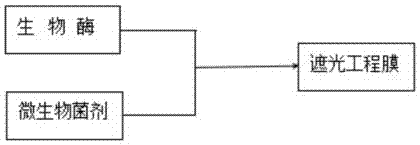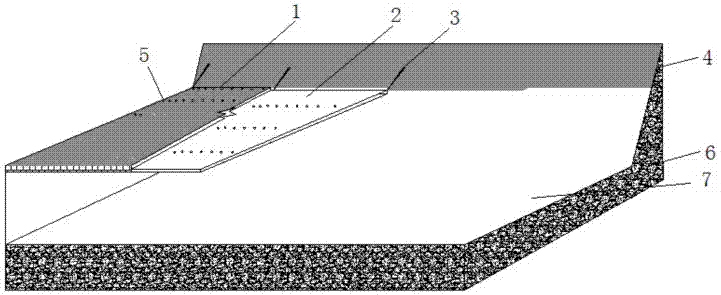Method for treating blue-green algae in rivers, lakes and reservoirs
A lake and reservoir technology, applied in chemical instruments and methods, biological water/sewage treatment, water/sludge/sewage treatment, etc., can solve the problems of destroying biological population structure and ecological environment, negative effects of ecological restoration, and high cost, To achieve the effect of inhibiting the growth of cyanobacteria
- Summary
- Abstract
- Description
- Claims
- Application Information
AI Technical Summary
Problems solved by technology
Method used
Image
Examples
Embodiment 1
[0038] From May to October, the test site is a reservoir in Jinhua, Zhejiang Province, with a storage capacity of 1055m³, and the concentration of chlorophyll a in the water area before treatment is 0.0071mg / L.
[0039] The process of controlling blue-green algae in this embodiment is as follows: figure 1 Shown:
[0040] 1) Cover two layers of shading film in the local cyanobacteria enrichment area of the water area. The material of the shading film is PVC material, and the two ends of the shading film are fixed on the river bank. Its structure is as follows: figure 2 As shown, the area covered by the shading film is about 1000㎡.
[0041] The upper layer of shading film 1 and the lower layer of shading film 2 are fixed on the river bank slope protection 4 through the fixing device 3 (anchor cable). Air and water holes 5, the size of the air and water holes 5 is about 1cm, and the hole density is about 1000 / m 2 ; The air and water holes 5 of the upper and lower layers of ...
Embodiment 2
[0050] From May to October, the test site is a lake bay in Nanjing, Jiangsu Province. The test area is about 80m×80m, the average water depth is 5-8m, and the concentration of chlorophyll a in the water area before treatment is 0.0100mg / L.
[0051] In-situ enrichment and treatment of cyanobacteria using the composite technology of covering shading film combined with biological enzymes and microbial agents to treat cyanobacteria:
[0052] 1) Install three layers of light-shielding film in the test area. The light-shielding film is made of acrylic fiber. The air-water hole diameter on the light-shielding film is about 3cm, and the hole density is about 800 / m 2 , The air and water holes of the upper and lower layers of the shading film are staggered, and the distance between the shading film and the water surface is 20cm.
[0053] 2) After the water surface is covered with a shading film, inoculate microbial agents and biological enzymes in the bottom mud and water body of the wa...
Embodiment 3
[0057] From May to October, the test site is a river in Zhenjiang, Jiangsu Province. The average river width of the test site is about 35-45m, and the average water depth is 5-6m. The water treatment volume of the project is about 6.0×10 5 m³, the concentration of chlorophyll a in the water area before treatment was 0.0200mg / L.
[0058] In-situ enrichment and treatment of cyanobacteria using the composite technology of covering shading film combined with biological enzymes and microbial agents to treat cyanobacteria:
[0059] 1) Install two layers of shading film at the river bend. The shading film is made of polyester. The size of the air and water holes on the shading film is about 5cm, and the hole density is about 500 / m 2 , the air and water holes of the upper and lower layers of the shading film are staggered, the distance between the shading film and the water surface is 35cm; the area covered by the shading film is 3000m 2 .
[0060] 2) After the water surface is cove...
PUM
 Login to View More
Login to View More Abstract
Description
Claims
Application Information
 Login to View More
Login to View More - R&D
- Intellectual Property
- Life Sciences
- Materials
- Tech Scout
- Unparalleled Data Quality
- Higher Quality Content
- 60% Fewer Hallucinations
Browse by: Latest US Patents, China's latest patents, Technical Efficacy Thesaurus, Application Domain, Technology Topic, Popular Technical Reports.
© 2025 PatSnap. All rights reserved.Legal|Privacy policy|Modern Slavery Act Transparency Statement|Sitemap|About US| Contact US: help@patsnap.com


